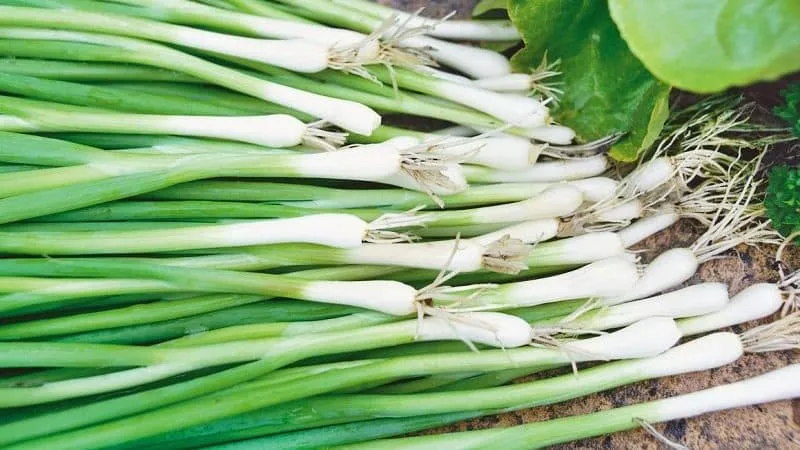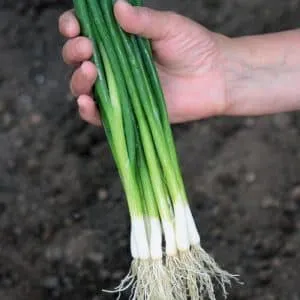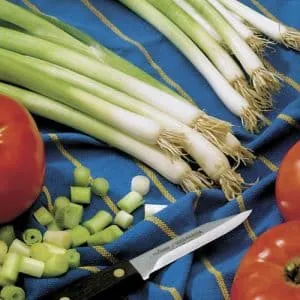While common onions are widely cultivated across Europe, Welsh onion (Allium fistulosum) receives less attention. However, a few popular varieties stand out, one of which is Parade. Its juicy greens have a semi-sharp taste and are packed with vitamins and minerals. Below, we explore the advantages and drawbacks of this onion, its key characteristics, and cultivation tips.
Table of contents
Description of Parade Onion
Parade onion does not form bulbs and is grown exclusively for its greens, which are perfect for salads, soups, marinades, and dishes featuring fish or poultry.
The Parade variety was developed by Dutch breeders from BEJO ZADEN B.V. It was officially registered in several European seed catalues in the early 2000s.

Chemical Composition, Micronutrients, Vitamins, and Health Benefits
Parade onion contains:
- plant-based protein, carbohydrates, and fats;
- vitamins A, C, E, K, PP, and B-group;
- amino acids;
- micro- and macronutrients: potassium, calcium, phosphorus, magnesium, sodium, zinc, copper, selenium, iron, and manganese.
Consuming this onion supports metabolism, heart health, detoxification, and helps prevent atherosclerosis. It also strengthens the immune system and promotes kidney health.
Maturation Period and Yield
Parade is a mid-early variety, taking about 60 days from planting to harvest.
This onion boasts high productivity – up to 4.2 kg per square meter.
Disease Resistance
Parade is resistant to diseases commonly affecting allium crops.
Bulb Characteristics, Appearance, and Flavor Profile
Parade onion is a tall plant, reaching up to 60 cm in height, with a robust, upright leaf rosette. Each plant weighs approximately 50-60 g.
The pseudostem (white part) is short, and no bulbs form. The leaves are cylindrical, growing from the base, with a greenish-blue hue and a thin waxy coating.
The greens are juicy, tender, and have a pleasant semi-sharp taste with a mild garlic aroma.
Note. Parade does not have strict climate requirements and thrives in various European growing conditions.
Advantages and Disadvantages of Parade Onion
Pros:
- high yield;
- frost resistance;
- suitable for open ground and greenhouses;
- long growing season;
- rich in vitamins and minerals.
The only "con" is that it doesn’t form bulbs, which is simply a characteristic of the variety.
Comparison with Other Varieties
See how Parade compares to other Welsh onion varieties:
| Variety | Leaf Color | Flavor | Plant Height (cm) | Plant Weight (g) | Yield (kg/m²) |
| Parade | Green with blue tint | Semi-sharp | Up to 60 | 50-60 | 4.2 |
| Tenderness | Green | Mild | Up to 53 | 50-60 | 4.2-4.6 |
| Performer | Bluish-green | Mild | 50 | 55 | 2.5 |
| Capital | Green-blue | Semi-sharp | Up to 55 | 12-16 | 1.8-2.1 |
Planting and Growing Guide
Parade can be grown in open ground or greenhouses, either through direct seeding or transplanting. The method depends on regional climate conditions, with transplants often used in cooler areas.
Preparation
For direct seeding, no pre-treatment is needed. For seedlings, soak seeds in a growth stimulant (e.g., BioBloom) for 24 hours to speed up germination.
 In autumn, prepare beds by deep-digging and adding organic matter (up to 10 kg/m²), phosphorus, and potassium. In spring, enrich soil with nitrogen (30-40 g/m²).
In autumn, prepare beds by deep-digging and adding organic matter (up to 10 kg/m²), phosphorus, and potassium. In spring, enrich soil with nitrogen (30-40 g/m²).
For seedlings, sterilize soil with a 2% potassium permanganate solution, then cover with dark plastic. After a week, remove the plastic and fertilize with potassium chloride (15 g) and superphosphate (20 g) per m².
Soil Requirements
Parade grows well in most soils but prefers light, organic-rich, well-draining substrates with a pH of 6-7.
Crop Rotation
Best planted after cucumbers, tomatoes, potatoes, or legumes.
Planting Schedule and Method
For direct sowing, plant seeds in early May.
Planting steps:
- Dig beds, adding nitrogen (40 g/m²).
- Level soil and create 1.5 cm-deep furrows, spaced 15-20 cm apart.
- Dust furrows with sand or chalk, sow seeds every 5 cm.
- Cover with soil, water lightly, and use row covers until germination.
For seedlings (sown in March):
- Fill trays (60x40 cm) with prepared soil.
- Make 1 cm-deep furrows, 5 cm apart.
- Mist with warm water.
- Sow seeds, cover with soil, and mist again.
- Cover with plastic and place in a bright spot (18-25°C).
- After sprouting, remove plastic and reduce temperature to ≤16°C.
Keep seedlings watered and fertilize every 10-14 days with organic/mineral mixes. Transplant outdoors after frost risk passes.
Growing Tips
For best yields, plant in sunny, sheltered spots.
In greenhouses, maintain 22°C (day) and 18-20°C (night) pre-germination. After sprouting, lower to 12-15°C for a week, then stabilize at 20°C.
Provide 24-hour light after a few weeks to prevent thin, pale greens.
Care includes watering, weeding, loosening, and fertilizing, with slight variations by growing location.
Watering
Parade has shallow roots, so keep soil moist (water weekly, ensuring no more than 3-5 cm dries out).
Weeding and Soil Loosening
Remove weeds regularly to prevent nutrient competition. Mulch between rows with straw or wood chips to suppress weeds.
Loosen soil 1-2 days after watering to improve aeration.
Fertilization
For outdoor plants, first fertilize when warm weather sets in, using a weed-based tea (steeped 2-3 days in 10L water).
At 3-5 leaves, apply potassium and phosphorus (1 tbsp each in 10L water). Repeat at 8 leaves.
Important! Fertilize in dry mornings, avoiding leaf contact.
In greenhouses, fertilize as needed. If greens pale or thin, use urea or Crystal Green (15 g/10L water).
Pest and Disease Management
Parade has strong resistance but may face downy mildew, Alternaria, gray mold, or onion flies/mites if mismanaged.
Treat with fungicides/insecticides at first signs, but wait 3 weeks before harvesting.
Common Challenges
Potential issues:
- Growth stalls above 27°C – stimulate with cool water.
- Poor growth from underwatering.
- Pest attraction if grown near bulb onions.
Harvest and Storage
Parade allows multiple harvests per season (year-round in heated greenhouses).
Harvesting
First harvest is mid-summer. Pull whole plants or cut leaves, repeating every 38-50 days (3-4 times/season).
Storage
Wrap greens in perforated cling film; refrigerate for up to a month.
Expert Tips
Recommendations:
- Water consistently – drought tolerance is limited.

- Burn diseased plants away from the plot.
- Pre-treat soil with boiling water to kill pathogens.
- Water in the morning to prevent moisture-related diseases.
- Avoid planting near bulb onions to deter pests.
Grower Reviews
Most gardeners praise Parade for its reliability and quality.
Paul, Germany: "I grow onions commercially, and Parade delivers – high yields, multiple cuts, and beautiful, juicy greens."
Valentina, France: "Our family prefers greens over bulbs. Parade is perfect – tasty, fast-growing, and productive even in small gardens."
Conclusion
Parade is a versatile, mid-season onion thriving across Europe. Its disease resistance, low maintenance, and excellent flavor make it a top choice among Welsh onion varieties.







